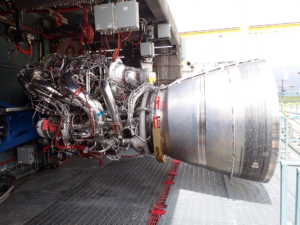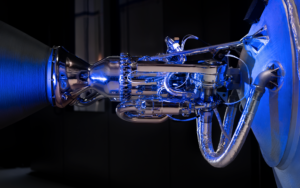
New Glenn Flight Hardware Is On The Move!
Only days ago, two BE-4 engines took flight for the first time and proved themselves as capable next-generation hardware. Now to continue a great year so far for the company, Blue Origin just rolled out a New Glenn booster, almost all of which is actual flight hardware. This is big news as it suggests upcoming testing and marks a big milestone in the launch vehicle’s development.
For months now we have seen various clues from the company showcasing landing legs, engine sections, etc. It seems now they have put most of these pieces together and are ready to move on to the next step. Here I will go more in-depth into the new images, what the future holds for this hardware, progress toward the first launch, and more.
New Glenn Flight Hardware

Earlier this morning images were taken by John Kraus showing teams moving a New Glenn booster from Blue Origin’s facility to what was thought to be the LC-36 launch pad. Here you can see not only the first stage mid-module, which consists of the two primary tanks for the Booster, but also the interstage and first stage aft module. The aft module is the extended portion at the bottom which houses the 7 BE-4 engines.
So far in the photos that we’ve seen, a tarp is covering the very bottom of the booster, hiding any engines if they are installed. What’s significant is that with the exception of the interstage, the entire booster is actual flight hardware and not just a structural article. Other images from different angles, for example, highlight plumbing just inside the interstage, which in reality is the top of the first stage’s LNG tank.
While impressive, this stage is still missing some key components before it’s a complete booster. One of the most obvious would be two large strakes toward the bottom of the stage. The plan is for two wing-like stakes to provide lift and cross-range for the first stage during its descent back to Earth. Once installed, they will extend from nearly the middle of the booster down to the aft module. In the updated images we can see what looks like mounting points in the form of holes along either side of the stage. Other additions would be stakes and aero covers for certain connections.
All that being said, these missing pieces are more so necessary for actual flight rather than initial testing. Even though a lot is still unknown as Blue Origin hasn’t officially said anything, many believe this rollout is just handling practice as teams get closer to actual tests. At the same time, full tanking tests and even static fires could be set to happen not too long from now depending on a host of factors.
One interesting point is that about a month and a half ago, images were captured of just a New Glenn mid-module, very similar to the one we are seeing now. In that case, the plumbing toward the bottom of the booster was visible in addition to other flight hardware features. It’s possible that in that relatively short period of time, Blue Origin worked to install an already complete or partially complete aft module along with the interstage. Now we are seeing a booster that is not far from completion.
Another aspect that these new images highlight is the impressive size of New Glenn. While it’s not as big as the 9m width Starship, it’s still a massive rocket with a 7m diameter. This is much larger than almost all other operational rockets within the industry. Its size when passing by nearby cars and structures helps put this in perspective. When a full upper stage is eventually added, New Glenn will become one of the largest rockets in the industry.
All things considered, It’s clear that Blue Origin is very close to testing this first stage. When that does eventually happen, that will be one of if not the biggest milestones in the project’s history. Something they are aiming to complete this year for a maiden flight that is closing in.
Upcoming Launch

As of right now, New Glenn technically has a launch scheduled to happen late this year. While extremely ambitious, the company is going to try its best to get hardware on the pad and eventually a rocket in the air. On the bright side, we are seeing much more progress in just the last few weeks alone than ever before. Vulcan’s first flight for example is a big deal for New Glenn as it demonstrates the capability of the BE-4 engines in flight. ULA is likely also in the process of sharing a host of invaluable engine flight data to Blue Origin allowing them to get a better understanding of the engine.
Two days ago when the launch happened, Blue Origin tweeted saying, “Congratulations @ULALaunch! Team Blue celebrates Vulcan’s first launch! #PoweredByBE4” With engine production also in high gear, the company should have a large amount of engines ready not only for ULA but also for New Glenn testing.
Focusing back on this launch vehicle’s first mission, last year NASA awarded Blue Origin a task order to provide launch service for the agency’s Escape and Plasma Acceleration and Dynamics Explorers (ESCAPADE) mission, as part of the agency’s Venture-Class Acquisition of Dedicated and Rideshare (VADR) launch services contract. In the statement, the agency is quoted saying, “ESCAPADE will launch on Blue Origin’s New Glenn rocket from Space Launch Complex-36 at Cape Canaveral Space Force Station in Florida. Launch is targeted for late 2024.”
ESCAPADE is a twin-spacecraft Class D mission that will study solar wind energy transfer through Mars’ unique hybrid magnetosphere. This specific mission type is considered high risk by NASA, which has to do with this being the first flight of New Glenn and on a very ambitious schedule. Recently, at a November 20 meeting of the NASA Advisory Council’s human exploration and operations committee, Bradley Smith, director of NASA’s Launch Services Program, said the agency’s Mars-bound ESCAPADE smallsats will fly on an “incredibly ambitious first launch for (Blue Origin’s) New Glenn” rocket “around this time next year.” He continued by saying, “We will very likely be the very first launch of New Glenn.” In the next few months, as we get closer, we can expect to hear more from Blue Origin and NASA about the progress and future timeline.
New Glenn after all is a complex and unique system. Taking a closer look at the hardware, the New Glenn primary booster is a reusable first stage with a length of 57.5 m (188.5 ft) and a tank diameter of 7 m (23 ft). As partially mentioned before, the stage consists of three sections: aft, mid, and forward. The aft module of the booster contains seven BE-4 LOX/LNG engines in addition to deployable landing legs. The restartable BE-4 engines are intended to provide precision thrust vector control and continuous deep throttle capability to support propulsive deceleration and landing maneuvers, while featuring long design life. The 8.5 m (28 ft) diameter engine skirt protects the engines from atmospheric reentry conditions and contains six stowed landing gear.
The mid module of the booster houses the fuel (LNG) and oxidizer (LOX) tanks. The tanks are made of orthogrid aluminum and are designed to withstand the high g-loads realized during reentry. The forward module of the booster features four actuated aerodynamic control fins for attitude control during descent. This section of the booster also provides ground umbilical connections for New Glenn and interstage housing of the two second stage vacuum-optimized BE-3U engines. The forward module houses various guidance navigation & control avionics, including an autonomous flight safety system. The pneumatic pusher stage separation system, which provides positive separation before second stage ignition, is located in the forward module.
Moving up the rocket, the second stage is an expendable LOX/LH2 stage with dual gimballing BE-3U engines with 1,060 kN (240,000 lbf) total thrust in vacuum. The stage also has a tank diameter of 7 m (23 ft) and uses common tooling with the first stage to reduce recurring cost. The length of the second stage tank is 16.1 m (52.9 ft) and the overall length including the two high expansion ratio nozzle BE-3Us is 23.4 m (76.9 ft). Similar to the first stage, the second stage has aft, mid, and forward sections. The aft section consists primarily of the two BE-3U engines, associated load bearing cross-bar thrust structure, and tankage/equipment for long duration operations.
On an actual mission, after second stage separation, the first stage booster reorients itself to reenter the atmosphere aft end first. Through a combination of aerodynamics and propulsive maneuvers, the stage performs a precision landing on the ocean-going platform in the Atlantic Ocean. This process is dependent on a host of factors especially including the BE-4 engine. At first Blue Origin planned to land on a large converted cargo ship but has since shifted in a different direction. Quite a while ago reports came out that instead, they were working with a contractor to build droneship landing platforms similar to SpaceX. Something we can look forward to seeing in action in the future.
Conclusion
New images showcase a nearly fully complete New Glenn first stage. Whats special is that it’s not just some structural build but actual flight hardware. We will have to wait and see how it progresses and the impact it has on the space industry.



